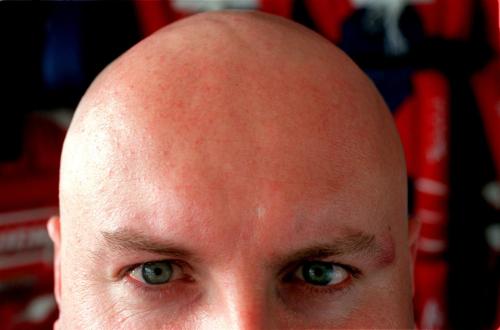 |
(MCT) |
Bald spots had an excessive amount of a protein called prostaglandin D2 or PGD2, according to a study in Science Translational Medicine. Merck’s experimental treatment for facial flushing and Actelion’s allergy compound, both in late- stage studies, block the protein.
About eight out of 10 white men experience some balding before the age of 70, according to the researchers. Johnson & Johnson (JNJ)’s Rogaine and Merck’s Propecia slow the loss, and some users see minor hair growth. Men may be able to regrow all their hair if the inhibiting protein is removed, said George Cotsarelis, chairman of dermatology at the University of Pennsylvania’s Perelman School of Medicine in Philadelphia.
“We really do think if you remove the inhibition, you get longer hair,” Cotsarelis, a study author, said in a telephone interview. “We don’t know” if the follicles will return to their former lengths, he said.
The study was funded by grants from the National Institutes of Health, the Pennsylvania Department of Health, and other medical groups.
Bald Parts
The researchers looked at all the genes in the scalp samples from five men, comparing the bald parts to the haired parts. They found higher expressions of the gene that produces PGD2 in the bald samples, compared to the spots with hair. With that as a guide, they found in samples of 17 men with hair loss that PGD2 was three times higher in the bald spots than where hair was growing. The scientists then used mice to show that excessive PGD2 decreased follicles.
Previous work has shown that the stem cells that create hair are still intact in bald men, Cotsarelis said. The follicles are also there, though they look smaller and produce thinner, shorter hair. Over time, the hair is so short it no longer passes the surface of the skin.
“This makes me wonder if this is the pathway,” said Paradi Mirmirani, a dermatologist at Kaiser Permanente in Vallejo, California. She wasn’t involved in the study. “In terms of therapeutics, it really opens the door to have someone come in and target these in a very narrow way.”
Final Studies
Merck, based in Whitehouse Station, New Jersey, is testing laropiprant as a flushing inhibitor to be administered with niacin. Allschwil, Switzerland-based Actelion’s setipiprant is being studied as a treatment for allergic inflammation of nasal pathways. Both therapies are in the final phase of testing generally needed for regulatory approval.
Merck isn’t studying the anti-flushing drug in hair loss, said Ian McConnell, a Merck spokesman, in a telephone interview. “We haven’t seen any signals” in patient trials that the therapy might reduce baldness, he said.
Actelion isn’t testing setipiprant as a baldness treatment, said Roland Haefeli, a company spokesman.
The role prostaglandins might play in hair growth was hinted at by Allergan Inc. (AGN)’s Latisse, which is an artificial version of prostaglandin F2-alpha, said Mirmirani. Latisse was originally developed for glaucoma, and doctors discovered it made eyelashes grow.
“They could pick out who was on it from the waiting room because of the super-long eyelashes,” Mirmirani said in a telephone interview. (Bloomberg)
<한글 기사>
대머리 원인 발견, 치료법 개발되나
남성형탈모증 원인으로 추정되는 단백질 발견
탈모 부위에 프로스타글란딘 D2 담백질이 더 많다는 사실이 발견돼 원형 탈모 치료에 대한 기대가 높아지고 있다고 사이언스 병진의학(Science Translational Medicine)에서 발표했다.
미국계 제약사 머크(Merck)와 바이오테크놀러지 기업인 스위스액텔리온(Actelion)에서는 프로스타글라딘 D2 담백질 억제제를 개발해 현재 최종 실험 단계에 있다.
“머리카락 성장을 억제하는 담백질을 제거한다면 지금까지 탈모 증상을 보인 남성들이 머리를 다시 기를 수 있을 것”이라고 펜실베이니아대학 피부과 조지 콧사렐리스(George Cotsarelis) 교수는 말했다.
이번 연구는 탈모 증상을 보이는 성인 남성 17명의 두피 세포 표뵨을 이용해 탈모 부위가 비탈모부위에 비해 프로스타글란딘 D2 담백질이 3배나 많다는 사실을 밝혀냈다.








![[Today’s K-pop] Blackpink’s Jennie, Lisa invited to Coachella as solo acts](http://res.heraldm.com/phpwas/restmb_idxmake.php?idx=644&simg=/content/image/2024/11/21/20241121050099_0.jpg)